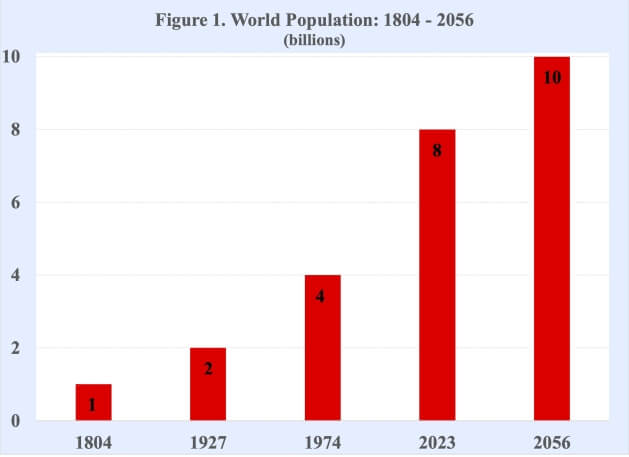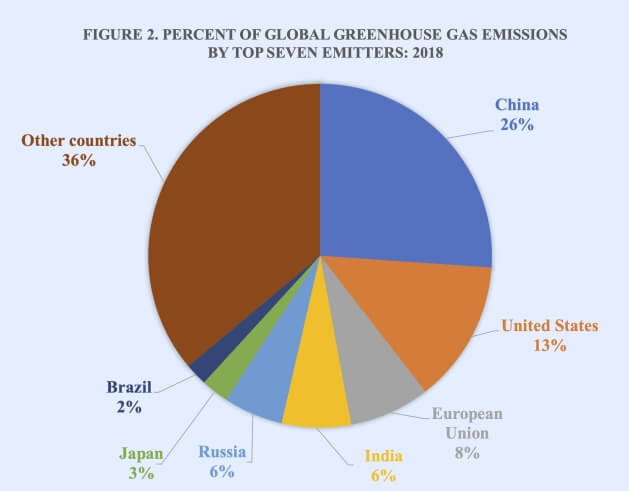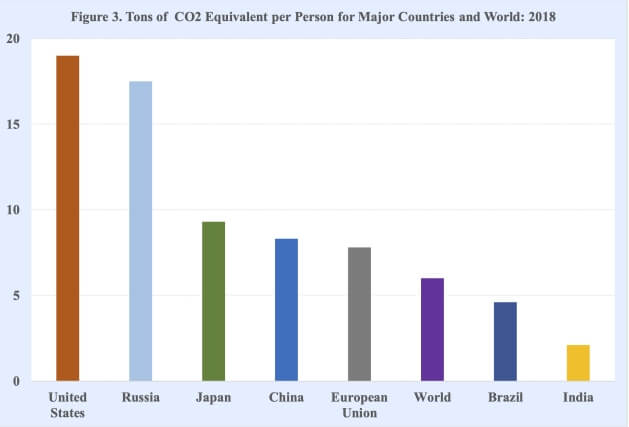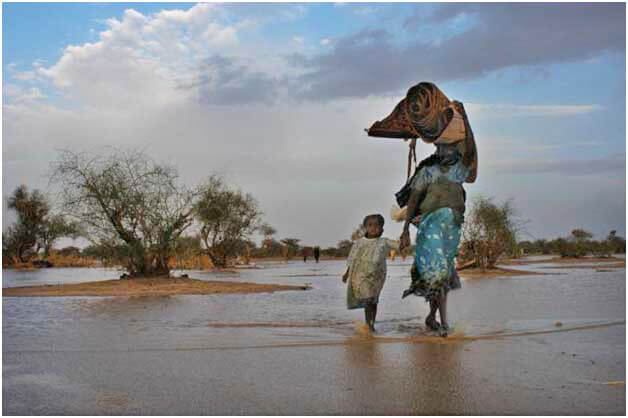– With world population approaching 8 billion humans, the demographic growth of nations is unfortunately largely ignored by governments whenever climate change is considered.
Government leaders at COP26, for example, did not address limiting the global demand for energy, water, food, housing, land, resources, material goods, machinery, transportation, etc. by reducing the growth of their respective human populations. By and large, the officials as well as their economic advisors are not prepared to acknowledge that population stabilization and degrowth are essential for addressing climate change.
Moreover, many countries, including Canada, China, European Union members, Iran, Israel, Japan, Russia, South Korea and the United States, continue to push for the further growth of their populations. China, for example, has moved from a one-child policy to a three-child policy to increase its population of more than 1.4 billion.
Russia has adopted a number of policies to increase its low birth rate, including maternity capital program, Procreation Day, state funding for new mothers, welfare benefits to families with young children and tax breaks for larger families. The United States relies heavily on immigration, more than one million immigrants annually, to increase its population, which is projected to reach 400 million by around midcentury.
Rather than immigration, most European Union Members aim to increase their populations by raising below replacement fertility levels. The mood in many parts of Europe is reflected in the German poster saying: “Wir können unsere eigenen Babys machen, wir brauchen keine Ausländer” (We can make our own babies, we don’t need foreigners). Hungary, in particular, has been outspoken in its opposition to immigration and foreigners, and straightforward in its policies, programs and financial incentives aimed at helping Hungarians have all the babies they want.
Also, Iran recently adopted a bill that limits sterilization, abortion and free distribution of contraceptives in the public health care system unless a pregnancy threatens a woman’s health, all aimed at raising its birth rate and increasing its population of 85 million by tens of millions over the coming decades. And Israel promotes population growth of its Jewish population and expansion of settlements as a prerequisite for security and economic development and its current population of 8.7 million could increase to 15 million by 2050.
Throughout most of human history demographic growth was relatively slow. The rapid growth of world population is relatively recent, having occurred largely during the second half of the 20th century with record breaking rates of growth and population increases. World population reached 1 billion around 1804, doubled to 2 billion in 1927, doubled again to 4 billion in 1974 and will double again to 8 billion by 2023 (Figure 1).

World population’s 10 billion mark is expected to occur around mid-century, with much of the growth taking place in less developed countries. Africa’s current population of about 1.4 billion, for example, is expected to double to 2.8 billion by 2056. Particularly noteworthy, Nigeria’s population, which increased more than fivefold over the past 70 years, is projected to double again, reaching 423 million by around midcentury and displacing the United States as the world’s third largest population.
It’s time to end the charade and acknowledge the disastrous consequences of a world with 8 billion humans is having on climate change. For example, based on the performance to date of Brazil, China, the European Union, India, Japan, Russia, the United States, the top 7 emitters of greenhouse gas emissions accounting for nearly two-thirds of global emissions and half of the world’s population, the world is unlikely to achieve the goals needed to address climate change nor respond effectively to environmental degradation and biodiversity loss (Figure 2).

Additional insight into greenhouse gas emissions is offered by per capita comparisons of major countries. While in 2018 the world average of tons of CO2 equivalent per person was approximately 6, the United States and Russia had the highest per person levels of 19 and 18, respectively. The per person levels for the world’s billionaire plus populations, China and India, were considerably lower at about 8 and 2, respectively (Figure 3).

It also appears unlikely that the world will achieve the global goal adopted by 196 parties in 2015 in the legally binding international treaty on climate change, the Paris Agreement, to limit global warming to well below 2, preferably to 1.5 degrees Celsius, compared to pre-industrial levels. Moreover, to preserve a livable climate on the planet, the world community of nations will not likely be able to reduce greenhouse-gas emissions net 0 by 2050.
While it is widely recognized that climate change is a global emergency, the international system of nations is failing to deal with this challenge as well as related global problems due to national ambitions. To effectively address this failing, some believe that a new worldview of planetary politics is called for, with the survival of the biosphere to be designated an international objective relevant to all nations. However, moving away from the primacy of national sovereignty to a planetary approach appears unlikely any time soon.
One significant demographic response to climate change is human migration, both internal and international. Increasingly, people are migrating to escape climate change’s disastrous consequences, including rising sea levels, lengthy droughts, deadly heat, polluted air, devastating floods, raging wildfires and violent storms.
The planet is all but guaranteed to see 5 feet of sea level rise in the coming decades. This rise is especially threatening to no less than a dozen island nations, including Fiji, Maldives, Marshall Islands, Micronesia, Seychelles, Solomon Islands and Tuvalu. In addition, by the end of the decade approximately 50 percent of the world’s population will live in coastal areas that are exposed to storms, tsunamis and floods.
Also, exposure to extreme heat, which has tripled from 1983 to 2016, now impacts roughly a quarter of the world’s population. Longer and hotter heat waves have become a regular feature of climate change. Low income communities, especially in developing countries, are most vulnerable with more than two-thirds of global households lacking access to air conditioning.
Governments will need to decide on how best to address climate-induced population displacement, which is already a reality for millions worldwide. Over the next several decades, tens of millions of “climate migrants” are expected to be displaced by extreme heat, droughts, sea-level rise, or other severe climate events within and across countries. Some are calling for a United Nations special rapporteur on human rights and climate change.
Other expected demographic responses to climate change are reduced fertility and increased morbidity and mortality. Hot weather, for example, can worsen reproductive health and maternal health outcomes as well as lead to later birth rates and harm to infant survival.
Also, climate change is considered the single biggest health threat facing the world’s 8 billion humans. Changes in the planet’s climate are expected to have serious consequences on the social, economic and environmental determinants of health, including air, water, food and shelter.
WHO reports that between 2030 and 2050, climate change is expected to cause 250 thousand additional deaths annually from malnutrition, malaria, diarrhea and heat stress. Also, others estimate that global warming could lead to the premature deaths of more than 80 million people over the remainder of the century.
Whenever climate change is discussed, written about, or mentioned, the demographic growth of nations can no longer be ignored or dismissed by governments. The planet with 8 billion humans and continuing to grow must be seriously addressed in climate change negotiations.
In brief, the stabilization and degrowth of human populations are essential for limiting the ever-increasing demographic created demands for energy, water, food, land, resources, housing, heating/cooling, transportation, material goods, etc. that are responsible for the planet’s climate change, environmental degradation and biodiversity loss.
Joseph Chamie is a consulting demographer, a former director of the United Nations Population Division and author of numerous publications on population issues, including his recent book, “Births, Deaths, Migrations and Other Important Population Matters.”


























